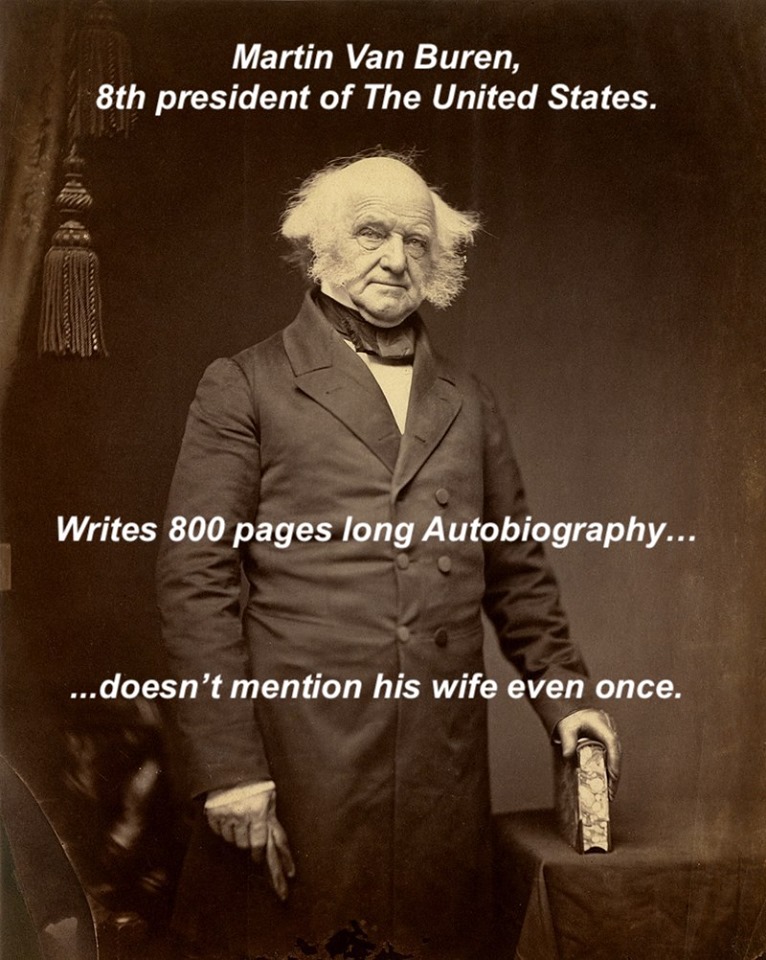
Martin Van Buren, 8th president of the United States wrote an 800 page autobiography, but didn’t mention his wife even once.
Ah, yes, ye Olde Misogyny, but was it really?
Hannah and Martin Van Buren were born in the same tiny community of Kinderhook, New York. They were, in fact, cousins, but they didn’t know then about genetics and the dangers of inbreeding. As cousins, they probably knew each other almost from the time of Hannah’s birth–a year after Martin’s. According to accounts by their contemporaries, they fell in love as children.
By the time he was fourteen, Martin had said he would marry Hannah but couldn’t until he had a way to support her. Martin was of modest means. His father was a farmer and tavern keeper with eight children and a wife to support. Martin left school at 14 and accepted the only gift his father could procure for him through his tavern connection: a job as a law clerk in far off New York City.
Law Clerk perhaps sounds more important than it was. He was an apprentice and basically a go-fer: he swept up the office and kept it clean, delivered messages, and filed papers. It paid next to nothing, but it gave him access to books of law. By night Martin hit those books. It took seven years, but by the time he was 21 Martin had passed the bar.
He could have stayed in New York, instead he went back to Kinderhook. and Hannah. He still had no money, but was able to open up a law firm with his half brother. They distinguished themselves by representing poor clients.
It took four more years to build up the business. He didn’t marry Hannah until she was 24 and he was 25–a little more than a decade after he had declared his intentions. Either one of them might have married someone else in the meantime, and certainly Martin, after establishing his firm, could have married someone else.

As Martin rose in prominence, Hannah hosted dinner parties for clients and contacts. She was sociable and lively, and their guests described their marriage as a happy one. Hannah and Martin were both of Dutch descent, and in fact, Dutch was Hannah’s first language. She never lost her Dutch accent. In public, Martin referred to her by a nickname he’d given her: “Jannetje”–Dutch for Hannah.
Despite being a woman of means, Hannah, like Martin, believed in service to the poor. Through her church she participated in many charitable causes, and was known for actually going to the homes of the poor and mingling with them. This wasn’t done by the other fashionable ladies at the time.
Together they had six children, though one died. It was during her pregnancy with the last that Hannah contracted tuberculosis. She managed to deliver the baby successfully, but the pregnancy and delivery weakened her. She died at the age of 35–18 years before Mr. Van Buren became President Van Buren.
It was fashionable at the time for pallbearers to be bought matching scarves. Mrs. Van Buren had requested that the money for those scarves be donated to charity to help the poor. Mr. Van Buren honored her dying request…
…And then he never mentioned her name again. Not to his children, not in his autobiography. When his son wanted to name a daughter after his mother, he had to confirm his mother’s name–perhaps because he remembered his father referring to her as Jannetje, yet the tombstone saying she was Hannah.
Martin also never remarried.
Van Buren built his entire early career around his Jannetje. They had shared convictions, and were in each other’s lives 35 years.
At the time they married, the woman’s vows included the words, “obey.” Did he blame himself for her death? Did he wonder over and over if he had just put his foot down and made her stop her charitable adventures she would she not have contracted TB? (TB loves the overcrowded, grimy, malnourished conditions of poverty. And it is often contracted by people who have weakened immune systems–who suffer from diseases like HIV, or malnutrition, or are pregnant.)
We can only speculate, but it seems he never recovered from her death.